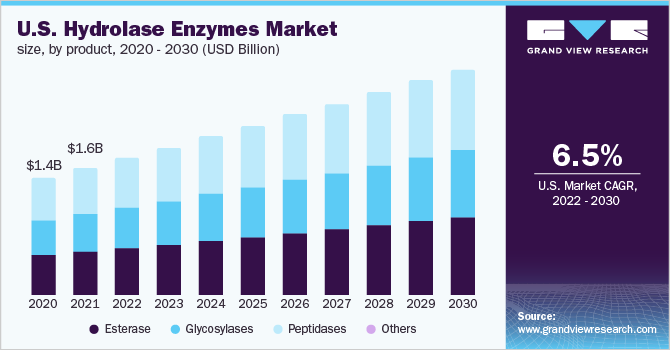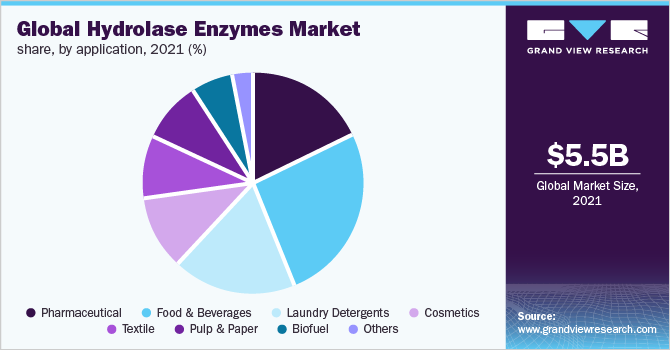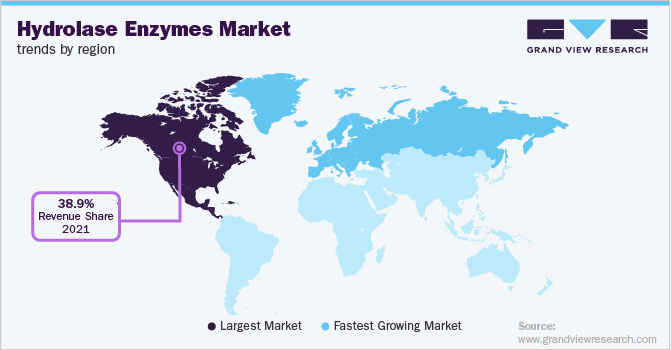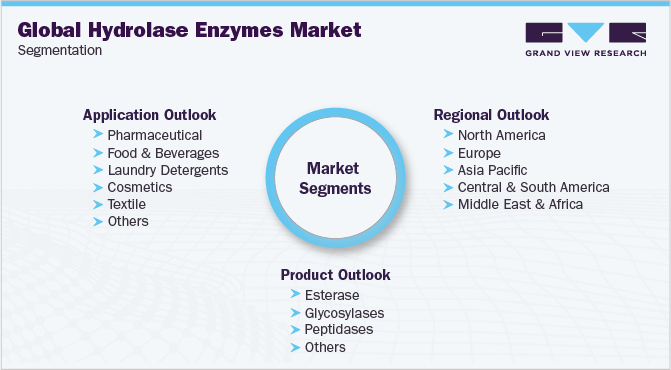- Home
- »
- Catalysts & Enzymes
- »
-
Hydrolase Enzymes Market Size & Share Report, 2022-2030GVR Report cover
![Hydrolase Enzymes Market Size, Share & Trends Report]()
Hydrolase Enzymes Market Size, Share & Trends Analysis Report By Product (Esterase, Glycosylase), By Application (Pharmaceutical, Food & Beverage), By Region, And Segment Forecasts, 2022 - 2030
- Report ID: GVR-4-68039-981-5
- Number of Report Pages: 140
- Format: PDF, Horizon Databook
- Historical Range: 2018 - 2020
- Forecast Period: 2022 - 2030
- Industry: Specialty & Chemicals
Report Overview
The global hydrolase enzymes market size was valued at USD 5.53 billion in 2021 and is expected to expand at a compound annual growth rate (CAGR) of 6.6% from 2022 to 2030. The key hydrolase enzymes are lipases, glycosidases, esterases, peptidases, nucleosidases, and phosphatases among others. The increasing prevalence of the product in the treatment of pancreatic insufficiency is expected to boost the demand in the forthcoming years. They help in treating several diseases on the account of their commercial availability, high stability, and catalytic efficiency.

Hydrolase enzymes are used in the diagnosis of bone diseases, autoimmune & inflammatory diseases, cancer, diabetes, liver diseases, myocardial infarction, kidney disorder, pancreatitis, and skin disorders. The increasing occurrence of diseases and environmental pollution is expected to drive the utilization of hydrolase enzymes in diagnostics applications.
Hydrolase enzymes are utilized in the food & beverages industry to improve the quality of products and enhance their shelf life. They are used for making fruit juices to improve the quality of fruits and increase juice yields. With the advent of different technologies including genetic engineering, manufacturers have an option to produce the necessary quantity of hydrolase enzymes in selected production hosts such as transgenic plants and microorganisms. Market players are using appropriate microorganisms, such as enzyme-producing yeast, bacteria, and fungi for commercial-scale production.
The value chain depicts the backward integration of key players, whose business operations range from the manufacturing of raw materials to the distribution of finished products. Novozymes, BASF SE, DuPont Danisco, Associated British Foods plc, and DSM are the key players integrated across the value chain.
Fermentation technology is extensively used in the production of hydrolase enzymes. The technology includes the usage of microorganisms such as bacteria and yeast for hydrolase enzyme production. Products manufactured by using this technology are suitable for use in several specialty applications such as biochemistry, microbiology, therapeutics, diagnostics, structural biology, and biocatalysts. Technological breakthroughs are considered some of the prime factors supporting growth.
BASF SE and Novozymes are the key market players undertaking extensive R&D activities for the development of required enzymes for unexplored applications. As manufacturers are focusing on backward integration, the raw material supply is currently stable. However, with the entry of new players in the hydrolase enzymes market, the demand for hydrolase enzymes and raw material supply scenario is likely to negatively impact growth in the forthcoming years.
Product Insights
Esterases dominated the hydrolase enzymes industry with the highest revenue share of 34.33% in 2021. The high revenue share of the segment is attributable to its extensive usage in industrial sectors as it contributes to environmentally sustainable design approaches such as gene therapy, anticancer, anti-tumor, dairy, agrochemicals, clothing, biosensor treatment, and the food and feed industry. It also helps in digestion while providing proteins and essential nutrients.
It helps decrease heartburn and indigestion, prevents bloating & gas, augments the ingestion of dairy products, and reduces food allergies. Growing inclusion of these enzymes as they help to provide relief from hiatal hernia and acid reflux will trigger the product demand. Ascending demand for medicinal drugs, extensive research activities, and strong funding initiatives are expected to fuel the product demand in the coming years.
Glycosylases are predominantly used to enhance digestive capacity. Dietary enzymes have gained prominence on account of growing digestion issues among individuals, which is anticipated to fuel the product demand in the nutraceutical sector. Moreover, they are used for several health issues including gluten intolerance and joint health. The aging population and increasing cost of healthcare are the key drivers for the increased product demand across regions.
Application Insights
Food & Beverage dominated with the highest revenue share of 26.44% in 2021. Its high share is attributable to its growing use in fats & oils processing, grain processing, cheese processing, protein processing, fruit & vegetable processing, and several other food processing industries such as dairy, baking, cereal extraction, and brewing. It helps food manufacturers to produce higher yields, enhance the quality of the final products, reduce costs, optimize resources, minimize wastage, and lower environmental risks.
In the pharmaceutical sector, the key applications of hydrolase enzymes include diagnosing diseases, promoting wound healing, and killing disease-causing microorganisms. Growing population, high consumer demand, and rising awareness regarding diseases and their outcomes are factors expected to drive product utilization in pharmaceutical application. Moreover, the increasing research & development has resulted in increased product usage in drug formulation and delivery.

Hydrolase enzymes are widely used in laundry detergents as they help in removing soils containing proteins, polysaccharides, and lipids. They are generally used to remove deposits of starchy food products including custards, chocolate, gravies, mashed potatoes, oatmeal porridge, and spaghetti. Increasing utilization of detergents in industrial and household applications in the emerging economies of Brazil, China, and India are expected to drive the product demand for detergents.
Rising disposable income, changing lifestyles, and consumer awareness regarding skin problems are factors anticipated to drive the demand for personal care and cosmetics products, which is anticipated to fuel market growth. While personal care products for women have always been a strong category, the introduction of grooming products for men is expected to further propel the market growth over the forecast period.
Regional Insights
North America held the highest revenue share of 38.87% in 2021. This is attributed to the rising usage of hydrolase enzymes for diagnostic purposes and pharmaceuticals coupled with the presence of key market players. Increasing health awareness among consumers is anticipated to boost the demand across the region in the coming years. Moreover, the food & beverage application is growing significantly due to the increasing demand from the dairy and brewing sector.
In Europe, the product demand is witnessing substantial growth based on the rising adoption of technological advancements, the growing pharmaceutical and chemical industry, and growing strategic initiatives by prominent companies. The growing population along with the rapidly developing textiles industry in the region is expected to fuel the product demand in textile processing.
The demand for hydrolase enzymes in the Asia Pacific region is witnessing a rise owing to the rising production of pharmaceuticals and advancements in biotechnology. Rapid product growth in the detergent and animal feed industries is projected to propel the overall market growth across the region.

Australia is a prominent producer of red meat and livestock globally. According to Meat & Livestock Australia in 2020, the total red meat production accounted for 4.8 million tons. Increasing demand for animal feed and processed meat & food products is anticipated to drive the market growth in the country. Other factors contributing to the market growth include growing detergents demand in end-use applications, expanding the pharmaceutical industry in China and India, and increasing biodiesel production in Malaysia and Indonesia.
Central & South America is expected to witness significant growth over the forecast period due to the rising demand for enzymes in food & beverage, animal feed, textile, paper & pulp, personal care, pharmaceutical, and diagnostics. The region is anticipated to witness a high product demand on account of industrial growth along with urbanization in countries including Brazil.
Key Companies & Market Share Insights
The market is oligopolistic and is dominated by DSM, Novozymes AG, and DuPont Danisco. The product manufacturers are focusing on environmentally friendly technologies for product modifications. Industry participants supply their products through various modes of distribution such as direct supply, third-party supply agreements, and online portals.Some prominent players in the global hydrolase enzymes market include:
-
Creative Enzymes
-
Advanced Enzyme Technologies
-
Infinita Biotech Private Limited
-
Antozyme Biotech Pvt. Ltd.
-
Novozymes
-
Specialty Enzymes & Probiotics
-
Aumgene Biosciences
Hydrolase Enzymes Market Report Scope
Report Attribute
Details
Market size value in 2022
USD 5.96 billion
Revenue forecast in 2030
USD 9.82 billion
Growth rate
CAGR of 6.6% from 2022 to 2030
Base year for estimation
2021
Historical data
2018 - 2020
Forecast period
2022 - 2030
Quantitative units
Volume in Kilotons, Revenue in USD Million, and CAGR from 2022 to 2030
Report coverage
Revenue forecast, volume forecast, company ranking, competitive landscape, growth factors, and trends
Segments covered
Product, application, region
Regional scope
North America; Europe; Asia Pacific; Central & South America; Middle East & Africa
Country scope
U.S.; Canada; Mexico; Germany; U.K.; France; Italy; Spain; Russia; Denmark; The Netherlands; China; India; Japan; South Korea; Brazil; Argentina; Saudi Arabia; South Africa
Key companies profiled
Creative Enzymes; Advanced Enzyme Technologies; Infinita Biotech Private Limited; Antozyme Biotech Pvt. Ltd.; Novozymes; Specialty Enzymes & Probiotics; Aumgene Biosciences
Customization scope
Free report customization (equivalent up to 8 analysts working days) with purchase. Addition or alteration to country, regional & segment scope.
Pricing and purchase options
Avail customized purchase options to meet your exact research needs. Explore purchase options
Global Hydrolase Enzymes Market Segmentation
This report forecasts volume and revenue growth at global, regional, and country levels and provides an analysis of the latest industry trends in each of the sub-segments from 2018 to 2030. For this study, Grand View Research has segmented the global hydrolase enzymes market report based on product, application, and region:

-
Product Outlook (Volume, Kilotons; Revenue, USD Million, 2018 - 2030)
-
Esterase
-
Glycosylases
-
Peptidases
-
Others
-
-
Application Outlook (Volume, Kilotons; Revenue, USD Million, 2018 - 2030)
-
Pharmaceutical
-
Food & Beverages
-
Laundry Detergents
-
Cosmetics
-
Textile
-
Pulp and Paper
-
Biofuel
-
Others
-
-
Regional Outlook (Volume, Kilotons; Revenue, USD Million, 2018 - 2030)
-
North America
-
U.S.
-
Canada
-
Mexico
-
-
Europe
-
Germany
-
U.K.
-
France
-
Italy
-
Spain
-
Russia
-
Denmark
-
The Netherlands
-
-
Asia Pacific
-
China
-
India
-
Japan
-
South Korea
-
-
Central & South America
-
Brazil
-
Argentina
-
-
Middle East & Africa
-
Saudi Arabia
-
South Africa
-
-
Frequently Asked Questions About This Report
b. The global hydrolase enzymes market size was estimated at USD 5.53 billion in 2021 and is expected to reach USD 5.96 billion in 2022.
b. The global hydrolase enzymes market is expected to grow at a compound annual growth rate of 6.6% from 2022 to 2030 to reach USD 9.82 billion by 2030.
b. North America dominated the hydrolase enzymes market with a share of 38.9% in 2021. This is attributable to the presence of several end-use manufacturers and growth in end-use industries such as food & beverages, pharmaceutical, and laundry detergents.
b. Some key players operating in the hydrolase enzymes market include Novozymes, Creative Enzymes, Advanced Enzyme Technologies, Infinita Biotech Private Limited, Antozyme Biotech Pvt. Ltd., Specialty Enzymes & Probiotics, and Aumgene Biosciences.
b. Key factors that are driving the market growth include growth in end-use industries, penetration of hydrolase enzymes across industrial applications, and surge in R&D activities related to product improvement.
Share this report with your colleague or friend.
![gvr icn]()
NEED A CUSTOM REPORT?
We can customize every report - free of charge - including purchasing stand-alone sections or country-level reports, as well as offer affordable discounts for start-ups & universities. Contact us now
![Certified Icon]()
We are GDPR and CCPA compliant! Your transaction & personal information is safe and secure. For more details, please read our privacy policy.
We are committed towards customer satisfaction, and quality service.
"The quality of research they have done for us has been excellent."





